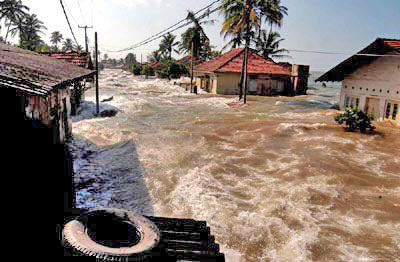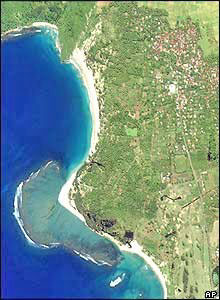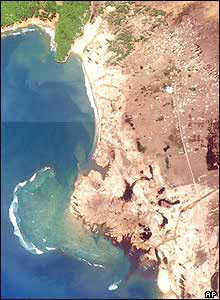|


by
Paul LaViolette
from
Etheric Website
Gamma Ray Bursts, Gravity Waves, and
Earthquakes
On December 26, 2004 a magnitude
9.3 earthquake occurred in the
Indian Ocean off the coast of Sumatra in Malaysia. It caused a
powerful tsunami which devastated coastal regions of many countries
leaving over 240,000 people either dead or missing. It was the worst
tsunami to affect this area since the explosion of Krakatoa. The
earthquake that produced it was so strong that it exceeded by a
factor of 10 the next most powerful earthquake to occur in the past
25 years.
• Indonesian 9.3 Richter
earthquake:
December 26, 2004 at 00 hours 58 minutes (Universal Time)
It is then with some alarm that we learn
that just 44.6 hours later gamma ray telescopes orbiting the Earth
picked up the arrival of the brightest gamma ray burst ever
recorded!
• Gamma ray burst arrival:
December 27, 2004 at 21 hours 36 minutes (Universal Time)

This gamma ray blast was 100 times more
intense than any burst that had been previously recorded, equaling
the brightness of the full Moon, but radiating most of its energy at
gamma ray wavelengths. Gamma ray counts spiked to a maximum in 1.5
seconds and then declined over a 5 minute period with 7.57 second
pulsations. The blast temporarily changed the shape the Earth’s
ionosphere, distorting the transmission of long-wavelength radio
signals. See stories on
Space.com,
BBC News,
NY Times.

Artists conception,
courtesy of NASA
It was determined that the burst
originated from the soft gamma ray repeater star, SGR 1806-20, a
neutron star 20 kilometers in diameter which rotates once every 7.5
seconds, matching the GRB pulsation period. SGR 1806-20 is located
about 10 degrees northeast of the Galactic center and about 45,000
light years from us, or about twice as far away as the Galactic
center. It released more energy in a tenth of a second than the Sun
emits in 100,000 years. Other gamma ray bursts have been detected
whose explosions were intrinsically more powerful than this one at
the source of the explosion, but since those explosions originated
in other galaxies tens of thousands of times more distant, the
bursts were not nearly as bright when they reached our solar system.
What makes the December 27th gamma ray burst unique is that it is
the first time that a burst this bright has been observed, one that
also happens to originate from within our own Galaxy.
Astronomers have theorized that gamma ray bursts might travel in
association with gravity wave bursts. In the course of their flight
through space, gamma rays would be deflected by gravitational fields
and would be scattered by dust and cosmic ray particles they
encountered, so they would be expected to travel slightly slower
than their associated gravity wave burst which would pass through
space unimpeded. After a 45,000 year light-speed journey, a gamma
ray burst arrival delay of 44.6 hours would not be unexpected. It
amounts to a delay of just one part in 9 million. So if the gravity
wave traveled at the speed of light (c), the gamma ray burst would
have averaged a speed of 0.99999989 c, just 0.11 millionths slower.
There is also the possibility that at the beginning of its journey
the gravity wave may have had a superluminal speed; see
textbox
below.

Artist’s conception,
courtesy of NASA
The 9.3 Richter earthquake was ten times
stronger than any other earthquake during the past 25 years, and was
followed just 44.6 hours later on December 27th by a very intense
gamma ray burst, which was 100 fold brighter than any other in the
past 25 year history of gamma ray observation. It seems difficult to
pass off the temporal proximity of these two Class I events as being
just a matter of coincidence. A time period of 25 years compared to
a time separation of 44.6 hours amounts to a time ratio of about
5000:1. For two such unique events to have such a close time
proximity is highly improbable if they are not somehow related. But,
as mentioned above, gravity waves would very likely be associated
with gamma ray bursts, and they would be expected to precede them.
Many have inquired if there might be a connection between these two
events (e.g., see the
Space.com article). Not thinking of
the gravity wave connection, astronomers have been reluctant to
admit there might be a connection since they know of no mechanism by
which gamma rays by themselves could trigger earthquakes. They admit
that the December 27th gamma ray burst had slightly affected the
ionization state of the Earth’s atmosphere, but this by itself should not have caused
earthquakes. However, if a longitudinal
gravity potential wave pulse were to accompany a gamma ray burst,
the mystery becomes resolved. The connection between earthquakes and
gamma ray bursts now becomes plausible.
In his
1983 Ph.D. dissertation,
Paul LaViolette called attention to terrestrial dangers of
Galactic core explosions, pointing out that the arrival of the
cosmic ray superwave they produced would be signaled by a high
intensity gamma ray burst which would also generate EMP effects
(e.g., see
HERE). He also noted that a
strong gravity wave might be expected to travel forward at the
forefront of this superwave and might be the first indication of a
superwave’s arrival. He pointed out that such gravity waves could
induce substantial tidal forces on the Earth during their passage
which could induce earthquakes and cause polar axis torquing
effects. In his book
Earth Under Fire (as well as in his
dissertation), he presents evidence showing that the superwave that
passed through the solar system around 14,200 years ago had
triggered supernova explosions as it swept through the Galaxy. Among
these were the
Vela and
Crab supernova explosions whose explosion
dates align with this superwave event horizon. He points out that
these explosions could be explained if a gravity wave accompanied
this superwave, it could have produced tidal forces which could have
triggered unstable stars to explode as it passed through.
He wrote at a time when gamma ray bursts had just begun to be
discovered, and when no one was concerned with them as potential
terrestrial hazards. In recent years scientific opinion has come
around to adopt LaViolette’s concern, as can be seen in news
articles discussing the SGR 1806-20 gamma ray outburst, e.g., see
Space.com news story. They note that if this gamma ray burst had
been as close as 10 light years it would have completely destroyed
the ozone layer. By comparison, the Galactic superwaves LaViolette
has postulated to have been generated as a result of an outburst of
our Galaxy’s core and to have impacted the Solar system during the
last ice age would have impacted the solar system with a cosmic ray
electron volley having an energy intensity 100 times greater than
this hypothetical 10 light year distant stellar gamma ray burst. In
comparison, SGR 1806-20 has been estimated to have a stellar
progenitor mass of 150 solar masses, whereas our Galactic core
has a
mass of 2.6 million solar masses. In its present active phase,
SGR
1806-20 is estimated to have a luminosity 40 million times that of
the Sun, whereas during its active phase the Galactic center could
reach luminosities of 400 trillion times that of the Sun. So it is
understandable that if the Galactic center were to erupt, it would
produce a gamma ray burst and a gravity wave far more intense than
the outburst from this star.
If anything, the December 27, 2004 gamma ray burst shows us that we
do not live in a peaceful celestial environment. And if the December
26th earthquake was in fact part of this same celestial event, we
see that this stellar eruption has claimed many lives. For this
reason, it is important that we prepare for the possibility of even
stronger events in the future, the arrival of superwaves issuing
from the core of our Galaxy. Like the December 26th earthquake and
the December 27th gamma ray burst, the next superwave will arrive
unexpectedly. It will take us by surprise.
 
Before
After
As a next step, it is advisable to
investigate data from gravity wave telescopes to see if a celestial
gravity wave may have arrived immediately prior to the December 26,
2004 earthquake. Since seismic waves from the Indonesian earthquake
would have taken some time to propagate through the Earth to these
gravity wave antenna, their signature could be distinguished from
the gravity wave coming from SGR 1806-20.
LIGO (Laser Interferometer Gravity
Wave Observatory), which consists of two correlated telescopes, one
in Washington and one in Louisiana, each having a 4 kilometer long
laser interferometer beam path, was in the process of being made
operational and unfortunately was not collecting data at that time.
The TAMA gravity wave antenna in Japan may have been operational
during the December time period however they apparently do not
answer telephone calls and have no posted email address. So it has
not been possible to contact their scientific team.
Superwave Monitoring Center
Those interested in monitoring earthquake, gamma ray burst, cosmic
ray background activity, and gravity wave bursts may try the
following websites:
• Current earthquakes:
http://earthquake.usgs.gov/recenteqsww/Quakes/quakes_all.html
• Past earthquakes:
http://earthquake.usgs.gov/activity/past.htmlpast.html
• Gamma ray bursts:
http://grad40.as.utexas.edu/grblog.php?author=D. Gotz
• Cosmic ray radiation intensity:
http://cr0.izmiran.rssi.ru/mosc/main.htm
• Gravity wave bursts (LIGO site: no posted data, just
posted papers):
http://www.ligo.caltech.edu/
and
http://www.ligo.org/results/
The December 27th GRB was not
accompanied by any rise in the cosmic ray background, indicating
that if it was accompanied by cosmic rays their intensity was unable
to exceed the relatively constant extragalactic background flux
arriving from distant galaxies. A Galactic superwave, on the other
hand, would most likely produce a substantial rise in these levels.
Note that almost two months passed before the December 27th gamma
ray burst found its way into news media stories. If unusually
intense activity were to occur in the near future as the beginning
stages of a superwave arrival, it is hoped that scientists will not
keep this knowledge to themselves but rather allow the global news
media to disseminate the story quickly to inform the world.
|
A Superluminal Gravity Wave?
Experiments carried out by
Eugene Podkletnov show that a
shock front outburst produces a longitudinal gravitational wave that
travels forward with the burst. He has found that this gravity wave
pulse has a speed in excess of 64 times the speed of light (personal
communication).
Also Guy Obolensky has produced spark discharge
electric potential shock fronts and observed them to propagate
forward at speeds as high as 10 times the speed of light.
Observations suggest that the
gravity wave from an expanding stellar
explosion will decrease its superluminal speed and eventually
approach the speed of light as the shock front expands. But
meanwhile, the gravity wave will have obtained a headstart over the
electromagnetic wave radiation component traveling in its wake
(light waves, gamma rays, etc.).
So one would expect that the
gravity wave from such an outburst (and its resultant earthquake
activity) would precede the gamma ray burst component.
|
|





